|
Our Grand adventure began
on Delta Airlines flight # 'whatever' from San Jose to Gatwick London with
a stopover in Nashville. The flight was LONG!!!!!!!! All tolled it was
over 12 hours from San Jose to Gatwick.
At San Jose a Phillipino
security guard built like Arnold Swarzenegar stopped and searched me. Who
knows why, but the guy was cool and hey, I was on my way to my ancestral
homeland with a beautiful woman! And I was gonna gripe about a little
frisk? The ride over was bumpy. We sat on the right side of the plane,
behind the first bulkhead. This gave us plenty of legroom and our own
private TV screen. We took off our shoes, put our feet up on the wall and
enjoyed the ride. As much as you can with a sore butt and airline food in
your gut! It got real bumpy while we were out over the Atlantic and that
motivated me to prayer more than once.
Having Heather sleep curled
up against my shoulder was a little slice of Heaven. We had been
maintaining a long distance relationship between Indiana and San Jose for
about six months and looked at this trip as a kind of test. If we can
survive the long flights, being in a strange country, driving on the wrong
side of the road and shifting with a left hand, then our relationship
could survive anything eh?
Gatwick airport in London
came none too soon. They had these funny little suitcase carts that
actually worked excellently upon reflection, and they were FREE to use.
Maybe independence wasn't such a good thing? Heather rented the car and
off we went. At first I thought the clouds were neat and enjoyed the cool
weather. Little did I know that we would only see the sun 3 times in 3
weeks!
Speaking of oddities,
Heather and I decided to start keeping a list of all the unusual things
that set Scotland apart from the United States. It didn't take us long to
figure out there are many more differences between the two countries than
a different electric current and the way we drink tea! So, here for your
edification is a partial list of some of the more unique differences. And
no, none of these are urban legends.
-
Curbs are located on both
the median and shoulder of the highways.
-
No speed limit signs posted
in Scotland.
-
Electronic signs remind
drivers to drive on the left.
-
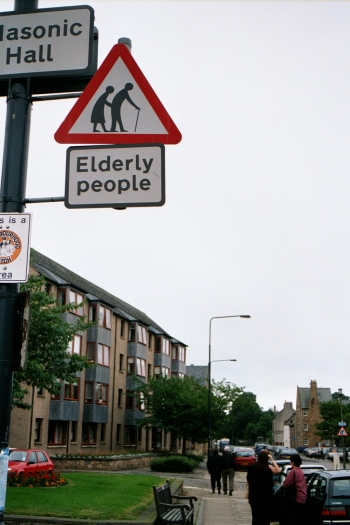 Road signs in residential
areas warn of "Elderly People" being present with a silhouette of two bent
over old people with canes walking with the words above them reading
"Elderly People". Road signs in residential
areas warn of "Elderly People" being present with a silhouette of two bent
over old people with canes walking with the words above them reading
"Elderly People".
-
Another roadsign "Humps for
one mile". (Heather and I were more than a little interested in the
meaning of this sign until, at 50 miles an hour, we were launched airborne
after hitting one of the 'humps'.
-
Yes, you drive on the left
side of the road and drive sitting on the right side of the car AND as a
result shift with your left hand.
-
The highways have pull-offs
that are about 50 yards long, 10 feet wide cutouts on the medians of the
roadway and run parallel to the highway. In other words, break down and
park on one of these and the 100 MPH traffic is ripping right alongside
where you are parked. People were eating lunch in one such pull out along
the Argyle freeway. Yep, right ON the freeway! Another family was having a
BBQ (you didn't read wrong) in one of these cutouts along a highway next
to Loch Fynne near Inverary. And yep, you guessed it; they had their
children there along with lawn and lounge chairs to make the whole
experience comfy!
-
All bathrooms have separate
spigots for hot and cold water, even the bathtubs. Makes washing your
hands either a blistering or freezing experience!
-
Almost all the bathrooms in
the Bed & Breakfasts have towel-warming racks.
-
We crossed several bridges
where only one car at a time may cross.
-
Traffic is regulated at
unattended work sites by portable stop and go lights.
-
Frequently, because of
roadwork or simply because someone had the audacity to park in front of
their house, cars, busses, trucks, etc will be coming down the middle of
the road right at you. In fact, you will see signs warning you of this in
several spots.
-
Roads are called
carriageways.
-
Passing lanes are called
crawling lanes.
-
Haybales are all round and
wrapped in black plastic.
-
Services along highways are
called 'Road Chefs'. Road Chefs (as well as hotels) are accessed by
turning off the highway directly into their parking lots. Interesting when
the traffic behind you is approaching at 100 miles per hour as you try to
slow down and make a 90-degree left hand turn into the parking lot. Oh,
and getting back onto the freeway and accelerating one of those powerful 4
cylinder compacts to get up to the flow of traffic (75 to 100 MPH) is
REALLY exciting! I never had to worry about stopping for Heather to use
the bathroom after making on of those merges!
-
The bridge tolls aren't
posted, so it's a crapshoot if you have the right change when pulling up.
And take more than a few sec's to figure it out? Learn about real English
hospitality!!!!!
-
Overpasses / overcrossings?
Nope, roundabouts. Maybe we should call them suicide circles. You pull up
to a round-a bout and see before you three rings (or more) of cars all
driving around what appears to be in a never-ending circle. Off of this
circle will intersect 2 or more roads that you will have to take to get to
your destination. So the round-a bout- viewed from a helicopter, would
look like a wheel hub, with the roads branching off looking like the
spokes. Your job, should you decide to accept it, is to dive into that
mass that mimics a school of fish, and drive until you see the street you
want branching off the round-a bout. If you happen to get into one of the
center circles (Sometimes you can't help it) changing lanes to get to the
outside can be quite the exciting adventure. And don't slow down and try
to read a directional sign because they WILL crawl up your rear in this
place!
-
Side note: many people will
be more than happy to give you directions. We found the Scottish people to
be overly generous in this regard. The only problem is, I don't think many
of them travel more than a few blocks from their home, because few of them
can tell you where to go if it is more than a mile or more away. They are
REALLY good about telling you to 'go North' 5 miles. But again, since
there is no sun, and since none of the road signs give compass directions,
IT'S A CRAPSHOOT AGAIN! Now, let's say that they actually give you
directions you can comprehend, well, those wonderful round-a-bouts usually
list their street names about every third round-a bout. What does this
mean to the average tourista? Well, you might see one street sign that
lists "Heather street' that-a way"…. And off you go happy as a lark
because you KNOW you are on the right path. You get to the next round-a
bout, and after circling the thing so many times there's a rut that
matches your tire size around the whole thing, you realize there is no
sign for 'Heather Street' at THIS round-a bout! Whata ya do? Guess! And
then, when you get through one or two more round-a bouts, if you don't
find 'Heather Street' you have to back track until you find the last
round-a bout that you saw the 'Heather street' sigh at and once again,
'guess' at the correct direction! Now, if there are 3 or more roads
branching off the round-a bout, well, let's just say you may have lunch
AND dinner consumed before you get to 'Heather Street'.
We drove about an hour and
a half to Louden, England where we went into our first bed and breakfast.
We chose Bed & Breakfasts because we wanted to meet and learn about the
people and because I wanted to splurge a little for Heather. The cost was
sometimes substantially more than hotels, but the atmosphere, furniture,
and the people we met made the extravagense worth it a thousand times
over.
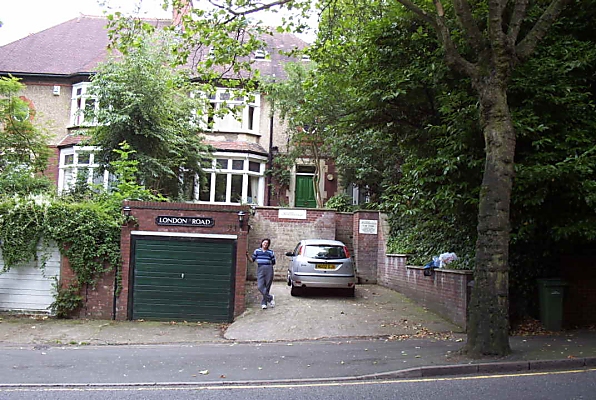
Heather eating at Hillhouse, Louden, England
We were overjoyed when the
owner of the house told us she was leaving for a holiday and we would be
served by her 'friend'. That was nice, but 'finding' the friend during the
stay was quite a challenge. The advantage was that we got to explore the
house and see some very interesting furniture as we hunted her down to
request such essentials as toilet paper and an explanation on how to use a
shower that looked like something out of the year 2020. This kind of
exploration became even more exciting when I realized that she was always
talking to herself and her voice seemed to come from every room in the
house. And don't tell me that her black cat wasn't giving me funny looks!
(We never did learn her name) To get to our room we went up some
narrow, squeaky stairs to find a door opened by a skeleton key and numbers
on all the doors. There was a beautiful double sized bed inside with the
most exquisite furnishings and nick knacks. The wood windows had
ultra-heavy drapes and they formed a semicircle facing the street in front
of the house. Unfortunately the window screen wouldn't close and so we
were visited by all sorts of nocturnal insect life during the nights.
Well, we wanted to experience 'everything' didn't we?
The shower was the size of
a high school locker and quickly dashed our hopes of a romantic shower
together. As the second day arrived we soon figured out that we would have
to make do with one 'thin' towel apiece and a showerhead that had the
force of a squirt gun. The hose on the showerhead was broken and so
adjusting the height above the setting for 'midget' was impossible!
What well made bed in
England doesn't have sheets? All of them! No bed we slept in had top
sheets. You have a bottom sheet and comforters on top and that's it! Make
you a little nervous? Yep, me too. Too late to fly home though, so now
what? PRAY!!!!!!!!!!!
Well, upon settling down
for the night we started to notice the non-stop traffic noise from the
street. Now, add that to the fact that there was no discernable way to
cool the room and we had to leave the window open for ventilation, the
traffic noise made for a rather enjoyable 1st night's stay. Wanting to
make the best of a 'challenging situation, Heather and I thought we could
'distract' each other for a couple hours. Well, the romantic-looking brass
bed squeaked like a mouse with its head in a vice and the pipes clanged
like 20 ringing church tower bells. So much for a distracting game of
'twister'.
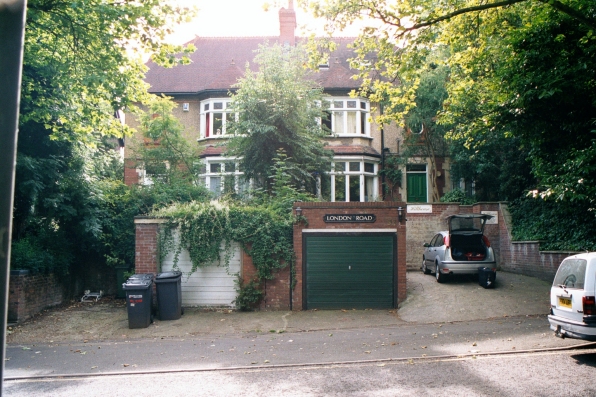
Shows how close B&B's are to the road and the
bow windows
Well, we finally got to
sleep around, oh 6, and at 07:00 am sharp some dude decided to wake the
American's up by slamming his car into the tree in front of our B&B. He
then spent the next half hour yelling at his woman for 'causing' him to be
late and crashing his car. He left the car there for 2 days! Oh, a little
something you might like to know. The majority of the residential streets
in Scotland are only wide enough for 2 cars to pass. So where do they park
you ask? Frequently right there on the street, so you have to stop and
wait for traffic coming the other way to pass before you can go around the
parked car and continue on your way. This gets really interesting when a
double Decker bus is coming the opposite direction because THEY stop for
no one and you'd better time your swerve around the car right or you'll be
playing chicken with the oh-so-friendly English bus drivers.
Heather and I were famished
when it came time for breakfast, though I fed a little of my breakfast to
the cat before I would take a bite! Our anticipation of a huge English
breakfast was fueled by the wonderful smells that continued to waft into
the living room during the 2 hours we waited for breakfast to arrive.
Imagine my utter relief that our hostess could see that I, a 225-pound
man, needed to shed a few pounds and only brought me ONE egg! And to top
it off, it was cooked my favorite way, sloppy and runny!
We decided to get out and
burn off the immense breakfast by visiting the Tower of London. We took a
train and then the subway and were dropped off almost at the Tower's door.
The train ride was beautiful. There are immense expanses of open
countryside beyond the boundaries of almost all English and Scottish
cities. We were thrilled to see vast expanses of wheat and hay stretching
for miles on both sides of the train. It is interesting to note that very
few fences can be seen anywhere in the countryside. Almost all the fields
are separated by hedges. Most are about waist high and dark in color. All
livestock must just naturally respect the hedges. Interesting. I was also
pleased to see hundreds of structures all made of brick. My family line
from Scotland has bricklayers and Mason's. The train traveled fast and
only stopped a few times on it's run to London.
The subway did present a
little bit of concern for us. I had been told by several people before
leaving the safe streets of San Jose that the subways were to be avoided
at all costs because of the gang-bangers and assorted weirdoes that
inhabited the dark depths of the subterranean subway environment. The cars
were very clean and the people either kept to themselves or were friendly
and courteous. Every question for directions met with a smile and helpful
advice. We encountered no problems except that it took a half-hour hike to
get from the train to the subway, all-underground.
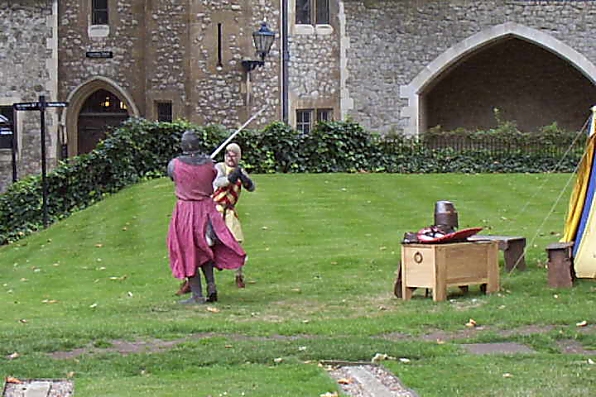
Battle re-enactments are performed around
various parts of the beautiful grounds within the Tower of London. Guided
tours by costumed guides are also available to the general public!
The Tower of London was not
a lone tower as we had imagined. Instead it is a fortified old castle that
has a huge (dry) moat around it. It sits right on the Thames River with an
excellent view of the London Bridge (the new one). Beautiful grass now
fills the moat, and additions to the masonry of the castle can
be seen in several places. The tower is filled with numerous museum rooms.
On exhibit were clothing, armament, crowns, furniture, military history
exhibits, and of course the actual Crown jewels we have all heard and read
so much about. Their beauty can never be done justice in any picture. The
immense sizes and quantity of precious stones is breathtaking!
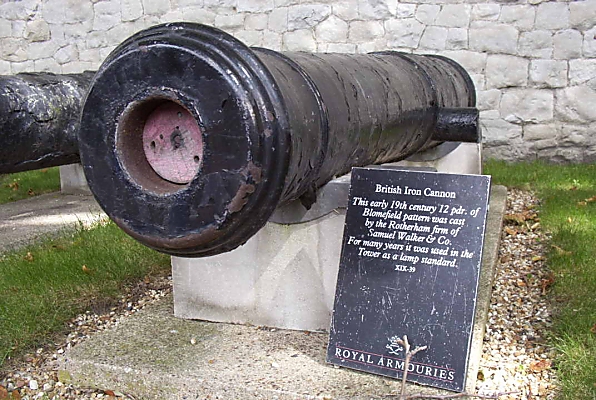
Canon at the Tower of London
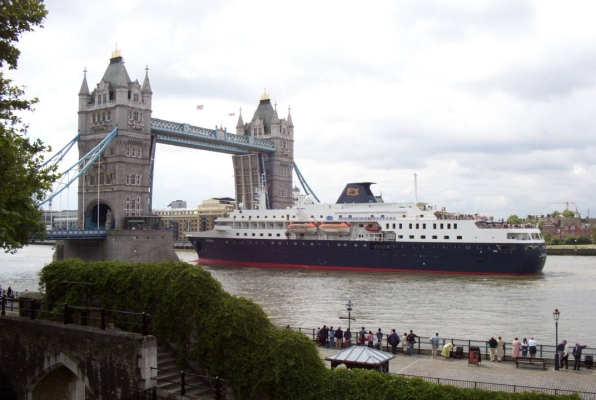
Tower Bridge
The next day we went to
Buckingham Palace. Heather wanted to see the dudes in tall puffy black
hats standing at attention and I wanted to see the female tourists flash
em to try and get em to smile. We were both sorely disappointed because
the whole place was locked down as a result of 9-11. No guards in red
suits with tall fuzzy black hats, and worst of all, no changing of the
guard! That was an utter disappointment. We consoled ourselves with a
stroll through St. James Park. It was immense and covered in beautiful
grass and historic military cannons and such. We ended up on a park bench
near a pond where I took a wonderful nap nestled on Heather's lap.
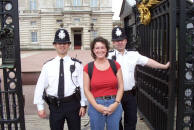
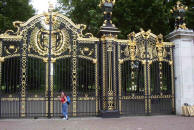
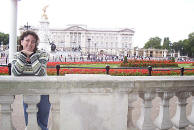
Day 3
We drove 6 hours north into
Scotland towards my ancestral town of East Linton. Once we hit Scotland
there were no speed limit signs and I took full advantage of a tourist's
ignorance of local vehicle code laws. I didn't worry about the limits
because I was passed like the proverbial tourist even when I was exceeding
speeds of 90 miles an hour.
There were several things
about Scotland that we started noticing right out of the parking lot at
Gatwick airport and continued to surprise us during the entire extent of
our trip. Of course the obvious was that we were driving on the 'wrong'
side of the road! Add to that I had to drive on the right hand side of the
car, AND shift with my left hand. Now THAT took some getting used to. We
started noticing some other subtle differences that added quite a bit of
mileage to our trip. There are no compass directions on the street signs
or along the highways. And since you never see the sun, you never know
what direction you are traveling. So even if you do have a map that shows
north and south, you can't tell which direction you are traveling anyway.
Highway curbs were another
curiosity. Where our medians (center divides) are separated by earth and
plants, so are Scotland's. But you never have to worry about someone
crossing over them because there are curbs on both sides of the highways!
Yep, median and shoulder are both bordered by raised asphalt curbs. Break
down and you'd better have enough steam to reach the numerous pullouts or
some 100 mile-per-hour semi driver will be crawling up your tail in a
heartbeat. Funny though, we never saw a tow truck in three weeks. And,
there are absolutely no pickup trucks in the entire country! No Dodge RAM
trucks, no 'like-a-rock' Chevys!
Immediately upon entering
East Linton we searched for my ancestral home. I don't get nervous over
much, but the ticker was slamming away as I first saw # 5 Bridgend. It was
much smaller than I expected at first glance. I admired the masonry work
and it was true, the house is integrated right into the bridge! We walked
all around the house and onto the grounds below the house that were
adjacent to the river Tyne. The grass along the side of the house was
beautiful and the greenery was unparalleled in its simple beauty. We met a
fisherman who said it was ok for us to walk along the river as it belonged
to the Queen, as long as we didn't hurt anything. I went to the small
waterfall and the area known as the Linn Rocks. A book was written about
East Linton and was titled "By The Linn Rocks" and can be found for sale
in several of the town's quaint shops.
Finding the house at
Bridgend was a geneology success story of strangers helping strangers
thousands of miles away. On an internet board for cops only I met and
befriended Alaistair Dinsmore of the Tayside police. Beginning in 1997 on
the internet, in conversation I casually mentioned to Alastair that I knew
only a few things about my grandfather's birth place in Scotland. Grandpa
had told me that he was born in a house on a bridge. That was it! In
looking up records, I had the names Tyne, East Linton, and Bridgend (
which I thought was the name of a street. Two weeks passed and Alastair
never let on that he knew anything about what I was referring to.
Imagine my utter shock when
I opened an e-mail from him entitled "your ancestral home"! Turns out
Alastair knew exactly what all those terms meant. East Linton was the town
through which the Tyne river flowed, under a bridge upon which a house sat
called, you guessed it "Bridgend"! Alastair traveled 55 miles from where
he lived to take an entire roll of film (which he sent me free of charge).
He also talked to the current inhabitants AND Ronnie Walker (not a
relative) who had a flower shop across the street and who confirmed that
my grandfather had in fact lived in the Bridgend house. Talk about hands
across the ocean!
The water in the Tyne was
dark green, very similar to what you find in the backcountry on the
Hawaiian Island of Kauai. For the end of summer it had quite a flow and
must run all year long. Upon close inspection it appeared that the bridge
had more than one style of masonry work done which indicated improvements
over the years.
We walked up the steps to
the front door and saw the Government plaque declaring this as an official
17th century house, though it looked much older to us. No one appeared to
be home and we left after about half an hour of looking around.
We went into town and
located a library where I intended to do some genealogy research. Nothing
was to be had there except the librarian knew the owners of the Bridgend
house! She called Mrs. Skinner, the owner of Bridgend house, but she was
no at home. Then the librarian told us of the Family History Library in
Haddington 7 miles away. She called over there for us and I made a
reservation to go there to begin my genealogical research.
The town of East Linton was
as I had imagined it. A quiet little burgh with old people walking the
sidewalks and a ton of old houses. The entire town was surrounded by wheat
fields and seeing ancient, dilapidated buildings was common. We went into
the miniscule post office and bought post cards to send to Heather's boys
and family. We had fun looking at the Scottish coinage that we received in
change.
We went to the Prestonkirk
graveyard and looked for headstones with 'Walkers' on them. Found none! I
was very surprised about that because I thought that we'd at least find
something from my family. The headstones were covered with moss and were
very interesting to look at. The church was very nice looking but closed
so we could not enter into it.
There was a small store
named 'Millers' where we bought Walker cookies, Walker chips, and some
snacks.
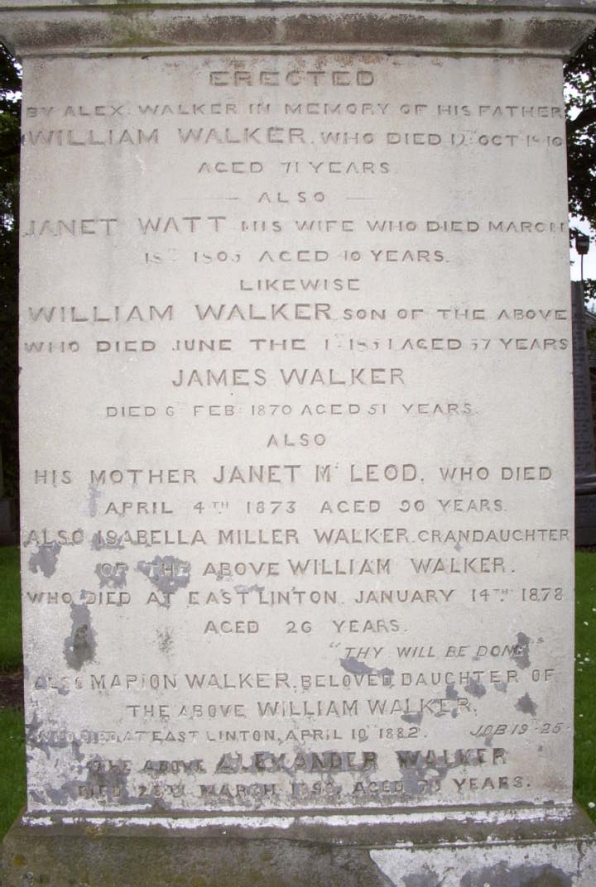
Prestonkirk Churchyard, Haddington / East
Lothian county.
Graveyards hold unimaginable resources! We walked right past this 5' tall
stone several times
over several days before actually seeing it? Amazing! This monument
confirmed in 'stone'
that my family had in fact been an integral part of life in East Linton
for generations!
Day 4 Tuesday, July 23rd.
We took the bus from
Dalkeith to Edinburgh to see the famous castle. This town was much bigger
than East Linton and had numerous high-rise buildings though few looked
very modern. Double decker busses were everywhere and the streets had
quite a few people walking around. We looked at kilts at a woolen mill
shop at midpoint on the main roadway. They said they could not provide us
with the Walker tartan we were looking for.
Standing on a high rock,
Edinburgh Castle was one of the strongest and most important fortresses in
Scotland. The oldest building is a small Norman chapel of the early 12th
century, dedicated to St Margaret, wife of Malcolm Canmore. The castle had
an English garrison from 1296 until 1313 during the Wars of Independence,
when the Scots, led by Thomas Randolph, climbed the rock, surprised the
garrison, and retook it. The castle was slighted, but there was an English
garrison here again until 1341, when it was retaken by a Scot's force
disguised as merchants. In 1367-71 David II rebuilt the castle with strong
curtain walls and towers, and a large L-plan keep, David's Tower, which
was named after him. After the murder of the young Earl of Douglas and his
brother at the 'Black Dinner' at the castle in 1440, it was attacked and
captured by the Douglases after a nine month siege, and required
substantial repairs. In 1566 Mary, Queen of Scots, gave birth to the
future James VI in the castle. After her abdication, it was held on her
behalf, until English help forced it to surrender in 1573. The castle was
captured in 1640 after a three-month siege by the Covenanters, and
Cromwell besieged it throughout the autumn of 1650. The Jacobites failed
to take it in both the 1715 and 1745 Risings. The castle is the home of
the Scottish Crown Jewels, and the Stone of Destiny - on which the Kings
of Scots were inaugurated - and is an interesting complex of buildings
with spectacular views over the capital. Visitors with a disability can be
taken to the top of the castle by a courtesy vehicle; ramps and lift
access to Crown Jewels and Stone of Destiny. Disabled facilities and WC.
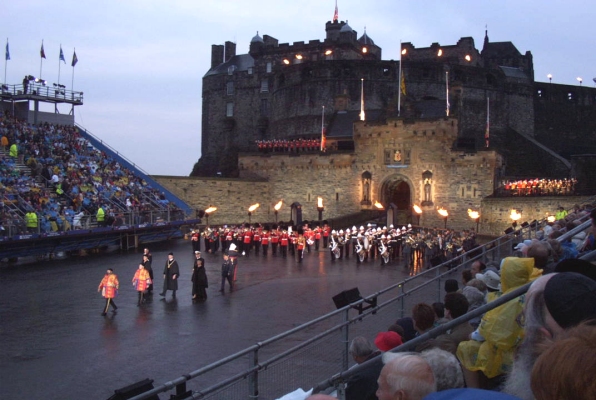
Opening ceremonies, Scotland Military Tattoo,
Edinburgh Castle, August 2002
We ate at the McGregors
tavern because it reminded me of my daughter's belief that our family is
related to the McGregor line. I wished both my kids were with me then. We
tried malt Scotch' for the first time and Heather mentioned oh so subtly
that it was bloomin hot!!!!!!!!!! We bought tickets for the Military
Tattoo (music festival) and ate some awesome chocolate in a quaint little
shop. We went into several shops and bought sweaters.
Day 5 - July 24th
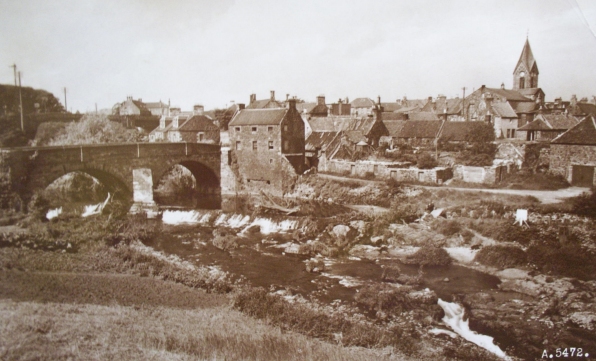
Bridgend House and the beginning of the
Famous Linn Rocks
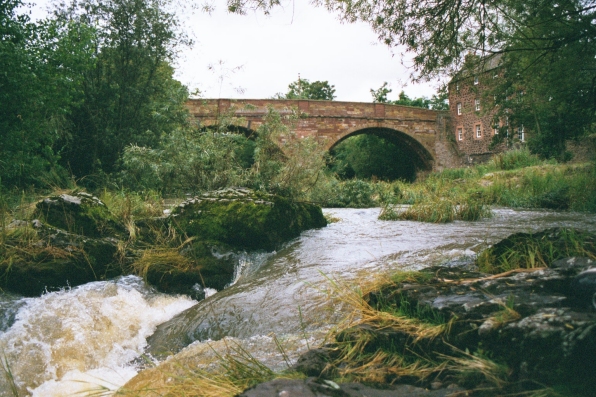
Bridgend House, in the town of East Linton as
it sits today. Pictured is the house on the right,
the river Tyne, and the begining of the famous Linn Rocks Falls in the
foreground.
We were staying at Gilston
House in Dalkeith, about 20 minutes from East Linton. 20 minutes if you
live there, between 30 and 60 minutes for us depending on how lost we got
each time we made the trip and got turned around by the round-a-bouts! We
called from 'Tish's' phone and spoke to Mrs. Skinner of
Bridgend house and arranged to meet with her two weeks hence when the
Skinners returned from holiday. We followed Tish to Leith to the shop
where Sean Conry bought his kilt. The proprietor said only one mill, the
Dunsdale Mill in Selkirk 2 hours south would have the ability to make the
Walker pattern we needed. Funny though, the salesman refused to call the
mill back and get directions for us. He told us we would have to drive to
the town and find it! And they call this customer service? Selkirk was
beautiful and it took us some time to find the Mill. Driving around
looking for it was pleasant because all of the country is beautiful beyond
description. We looked at 3 patterns and picked the 'old' Walker pattern,
paid for the kilt and jacket and vest from the owner himself. We returned
up north and arrived at our next stay 'Markle house'.
The view from the front of
the house was breathtaking. It was an old style house with a huge lawn out
front and surrounded by immense, beautiful trees. The driveway was loose
gravel and we loved the sound of our tires rolling over it as we entered
the property. The owners gave us a short tour and told us that the house
was built on the spot where a Scottish general saw the Scottish Saltire
flag in the sky and thus came about the flag of Scotland. Yea, well, even
the Scots take academic license when trying to attract visitors to their
dwellings. It seems many of the Scots made B&B's out of their houses to
make money. This couple was fairly affluent and sent their kids to private
school with what they made from the B&B. The whole house was filled with
antique furniture and just walking through the halls was an adventure. I
thought of all the times JR and Cassandra and I would watch Antiques
Roadshow and guess the prices of the antiques. What a surprise to be
staying in every house where they lived with a house full of the antiques
we saw every week on that show.
Our room was on the second
floor and we had a view of the countryside that was incredible. Old ruins
of an old castle were off in the distance and the house was surrounded on
all side by wheat fields. Each house we stayed at our hosts always graced
us the run of the house, but who had time or desire to just sit around in
the house, no matter how beautiful it was. We were on an adventure and it
did not include lounging around when we could be out exploring!
Day 6 July 25th
Heather and I found our
first castle today! I didn't expect much, because what kind of castle
could be within 2 miles of East Linton? We were to find out that if there
is a place for a castle, there may be one there. Castles were all over the
countryside and in every state of repair, or disrepair depending on the
location. Some were mere walls and others were in full use and lived in by
the local residents. Hailes Castle was everything we were expecting out of
a castle. Though technically in 'ruins', it had rooms and halls and cook
areas and all surrounded by beautiful woods and fields. The river Tyne ran
right below the castle and the setting was beyond romantic. We would have
taken advantage of the ambiance if a tourist hadn't wandered by. The
castles were of course all masonry and exploring through all the rooms,
halls, and out buildings was quite an adventure. Small placards like we
have in the US described the castle and it's inhabitants. Mary Queen of
Scots had been there frequently and Possibly Bonny Prince Charley. The
whole time we were there we were walking where all of histories greatest
people had tread! Beautiful green grass was everywhere and it was so
pleasant to walk on this soft carpet wherever we walked around Hailes. We
walked through the woods around the castle and found another small castle
and a bridge nearby. We decided right then that Hailes was to be our
favorite castle and it remained so through the entire trip, though there
were many contenders that we visited.
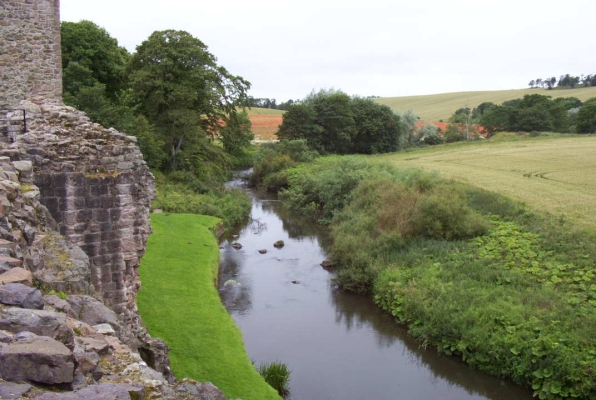
Hailes Castle on the Tyne river
In a lovely location above
a river, Hailes Castle consists of a 14th-century keep, extended by ranges
and towers in the 15th and 16th centuries, within a thick 13th-century
curtain wall. The castle had a large courtyard, fragments of which remain.
Hailes was a Hepburn property, having passed from the Cospatrick Earl of
Dunbar and March, and the de Gourlay family. Archibald Dunbar captured the
castle in 1443, and slew all he found within in the walls. Patrick Hepburn
became Earl of Bothwell, but was killed at the Battle of Flodden in 1513.
The castle was burnt in 1532, and in 1547 was occupied by Lord Gray of
Wilton for the English. James Hepburn, 4th Earl of Bothwell, brought Mary,
Queen of Scots, here after abducting her in 1567, and they married soon
afterwards. In 1650 the castle was partly dismantled by Cromwell. It
passed to the Stewarts, then the Setons, who in 1700 sold the castle to
the Dalrymples of Hailes, but was then abandoned for the mansion of New
Hailes, near Musselburgh. In 1835 Hailes was being used as a granary, but
in 1926 was transferred into State care.
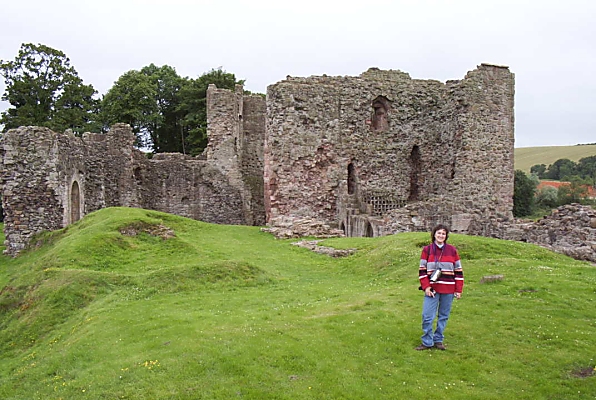
Hailes Castle, nestled amongst a beautiful
forest and lush farmlands. Hailes is fun to explore
and read about on the excellent document boards placed around the grounds.
That night Heather
surprised me and made arrangements to buy me dinner in my ancestral town
of East Linton at the 'Drover's Inn' restaurant. We went upstairs and had
the entire dining room all to ourselves most of the evening. I cannot
begin to tell you how romantic this trip was. Sitting across from Heather
in a room that was full of beautiful furniture, candlelight, and an
awesome waitress. Heather ordered haggis, but not before, out of a sense
of duty, the waitress forewarned Heather as to its contents. Heather said
'bring it on' and ate the whole thing. I must say that it was really good
and quite a surprise since it is made of EVERY part of a sheep imaginable.
There is definitely a difference in the alcohol content of Scottish beer
because 2 pints knocked me on my butt!
We went back to Markle
house and went for a walk in their fields across the street. We saw dozens
of rabbits and we conversed with a friendly horse that wandered by. I
jumped into a fighting stance as the waist high grass shook violently near
us. I had visions of some Scottish wildcat coming out at us! My vigilance
was rewarded by successfully protecting Heather from the wild rabbit that
broke out of the grass and went scampering down the lane. Heather delayed
our romantic walk by about ten minutes as she recovered from the insane
laughter that accompanied my heroic act. Some people!
Friday, July 26th.
We drove quite a distance
to the Stirling area and the William Wallace monument. This incredible
edifice was 6 or more stories high and made entirely of stonework. The top
was 246 steps up a stairway made for an anorexic midget. Every so often a
room would branch off the stairway and in these rooms we found the actual
sword that William Wallace carried. It was about 5 feet long and quite a
surprise to see in person. We bought a few things to bring back to the
families and proceeded up to the top of the monument that afforded us with
a 360-degree view of the Stirling area. There was a huge river running
nearby and we could see down into several tiny hamlets surrounding the
monument. The view was awesome and the climb well worth the effort for
everything we saw. I must say that we were a little dismayed that
everything we visited had a rather steep price for entrance. I do not
think they have state parks like we do that are subsidized for the
residents.
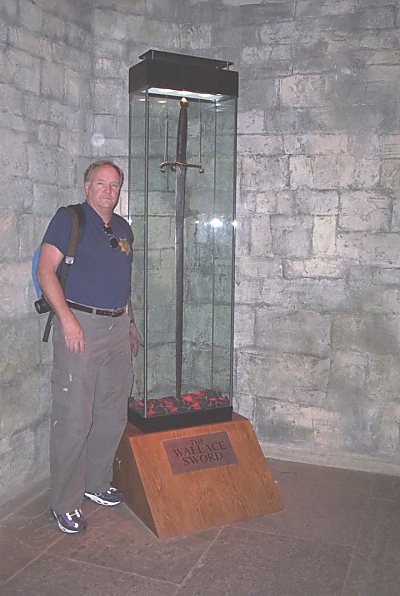
Inside the Wallace Monument. The handsome gent
(6' tall) is there to give
proportion to the size of the actual sword carried by William Wallace.
We went to Stirling castle,
a monument to beautiful masonry work and very exciting to search through.
Like most castles, it was on a hill with an awesome view of the
countryside. It had a rather large graveyard in which we found several
Walkers, but none that we could identify as connected. We went into a
nearby Abbey about lightfall and got into a rather interesting
conversation with a docent. If I was a short-tempered man I could very
easily have kicked his bum! He said quite a few derogatory things about
Americans and we left with a better understanding as to why some Scots do
not want independence from England. Actually he cooled down once he found
out we were both protestant and the rest of our conversation was cordial.

Stirling castle. A large number of windows
throughout the castle
contain beautiful glass in numerous colors and configurations.
One of the most important
and powerful castles in Scotland, Stirling Castle stands on a high rock,
and consists of a courtyard castle, which dates in part from the 12th
century. The castle is entered through the 18th-century outer defenses and
16th-century forework of which the Prince's Tower and the
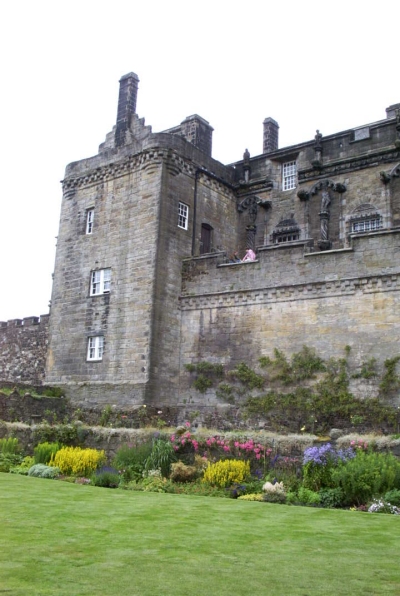 gatehouse
survive, but the Elphinstone Tower has been reduced to its base. The
gatehouse leads to the Lower Square, which is bordered on one side by the
King's Old Building, and on another by the gable of the Great Hall. A road
leads between the King's Old Buildings and the hall to the Upper Square.
The Chapel Royal is built on one side of the square, as is the Great Hall,
which was completed during the reign of James IV. Other features of
interest are the kitchens, the wall walk and the nearby 'King's Knot', an
ornamental garden, which once had a pleasure canal. The earliest recorded
castle at Stirling was used by Malcolm Canmore in the 11th century.
Alexander I died here in 1124, as did William the Lyon in 1214. Edward I
of England captured the castle in 1304 when he used - although after the
garrison had surrendered - a siege engine called the 'War Wolf'. William
Wallace took the castle for the Scots, but it was retaken by the English
until the Battle of Bannockburn in 1314. Robert the Bruce had the castle
slighted, but it was rebuilt by Edward III of England, after his victory
of Halidon Hill in 1333, in support of Edward Balliol. The English
garrison was besieged in 1337 by Andrew Moray, but it was not until 1342
that the Scots recovered the castle. James III was born here in 1451.
James II lured the 8th Earl of Douglas to it in 1452, murdered him, and
had his body tossed out of one of the windows, despite promising safe
conduct. Mary, Queen of Scots, was crowned in the old chapel in 1543, and
the future James VI was baptized here in1566. James VI stayed here in
1617, as did Charles I in 1633, and Charles II in 1650. In 1651 the castle
was besieged by Monck for Cromwell, but it surrendered after a few days
after a mutiny by the garrison. It was in a poor state of repair in the
18th century, but the garrison harried the Jacobites during both the 1715
and 1745 Risings. After 1745, the castle was subdivided to be used as a
barracks, but the army left in 1964. Exhibition of life in the royal
palace, introductory display, medieval kitchen display. Limited disabled
access and WC. gatehouse
survive, but the Elphinstone Tower has been reduced to its base. The
gatehouse leads to the Lower Square, which is bordered on one side by the
King's Old Building, and on another by the gable of the Great Hall. A road
leads between the King's Old Buildings and the hall to the Upper Square.
The Chapel Royal is built on one side of the square, as is the Great Hall,
which was completed during the reign of James IV. Other features of
interest are the kitchens, the wall walk and the nearby 'King's Knot', an
ornamental garden, which once had a pleasure canal. The earliest recorded
castle at Stirling was used by Malcolm Canmore in the 11th century.
Alexander I died here in 1124, as did William the Lyon in 1214. Edward I
of England captured the castle in 1304 when he used - although after the
garrison had surrendered - a siege engine called the 'War Wolf'. William
Wallace took the castle for the Scots, but it was retaken by the English
until the Battle of Bannockburn in 1314. Robert the Bruce had the castle
slighted, but it was rebuilt by Edward III of England, after his victory
of Halidon Hill in 1333, in support of Edward Balliol. The English
garrison was besieged in 1337 by Andrew Moray, but it was not until 1342
that the Scots recovered the castle. James III was born here in 1451.
James II lured the 8th Earl of Douglas to it in 1452, murdered him, and
had his body tossed out of one of the windows, despite promising safe
conduct. Mary, Queen of Scots, was crowned in the old chapel in 1543, and
the future James VI was baptized here in1566. James VI stayed here in
1617, as did Charles I in 1633, and Charles II in 1650. In 1651 the castle
was besieged by Monck for Cromwell, but it surrendered after a few days
after a mutiny by the garrison. It was in a poor state of repair in the
18th century, but the garrison harried the Jacobites during both the 1715
and 1745 Risings. After 1745, the castle was subdivided to be used as a
barracks, but the army left in 1964. Exhibition of life in the royal
palace, introductory display, medieval kitchen display. Limited disabled
access and WC.
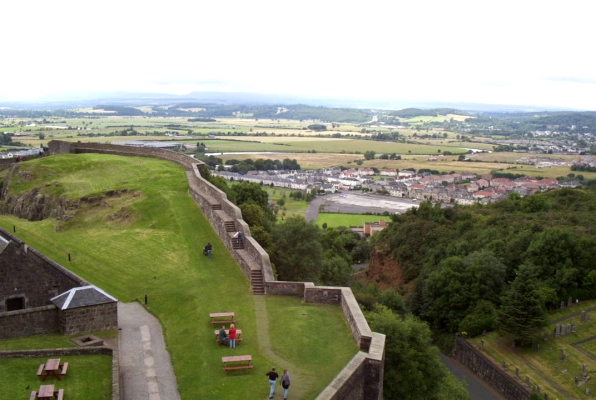
The views of, and around Stirling castle are
breath-taking!
Saturday July 27th
We went to the town of
Direlton because the tour guidebook stated it was the prettiest looking
town in all of Scotland! We drove around and it was one of the most
interesting towns we had seen. The housing and architecture was beautiful
and the views were wonderful. As we tooled around we could see a castle
off in the distance. We decided to adventure over to check it out. It
never ceases to amaze me that things like ancient castles are right on
residential streets here as if "oh well, here's another castle of unknown
antiquity that we PASS BY TO WORK EVERYDAY!!!!!
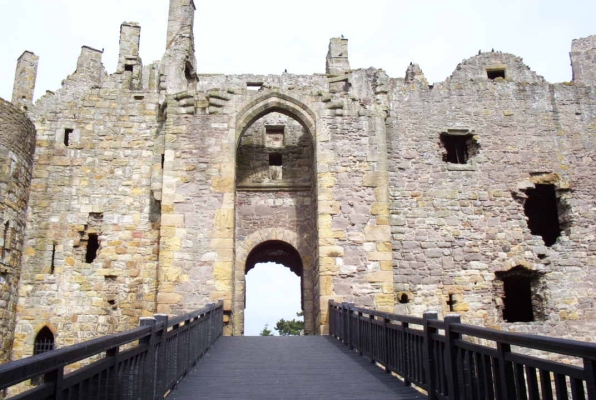
Entrance to Direlton castle
The castle had a rather
expansive lawn in front of it. We were dismayed to read that the castle
was closed and we'd have to wait over an hour for it to open. As we stood
on the roadside commiserating a Scottish gentlemen in a kilt came out of
the castle and said he would be more than happy to let us in early! Talk
about hospitality!
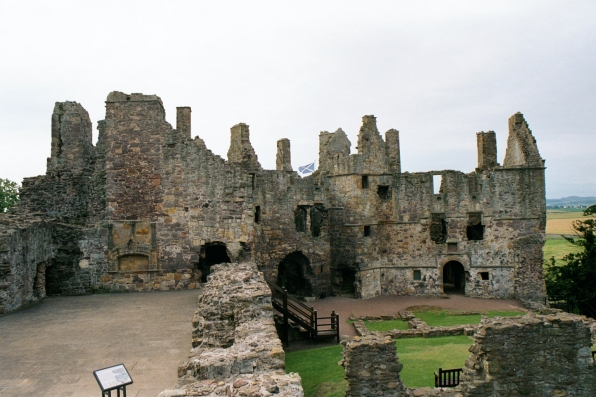
Direlton Castle. Nestled among some of the
most beautiful homes in Scotland.
Though in "ruins" this castle has numerous rooms to explore and staircases
to climb!
As he rung up our entrance
fee, I noticed a Knight's helmet sitting next to the register. Our clerk
told us he wears costumes when he works the different castles that he
works at and he also dresses for weddings and other occasions. He just had
this helmet made at considerable expense. Stepping outside the small shop
we were greeted by a magnificent garden with thousands of flowers of every
conceivable type in bloom! We took a few pictures and I must say that
Heather's beauty far eclipsed any of the flowers, and that they were an
acceptable compliment to the prettiest lass in Scotland!
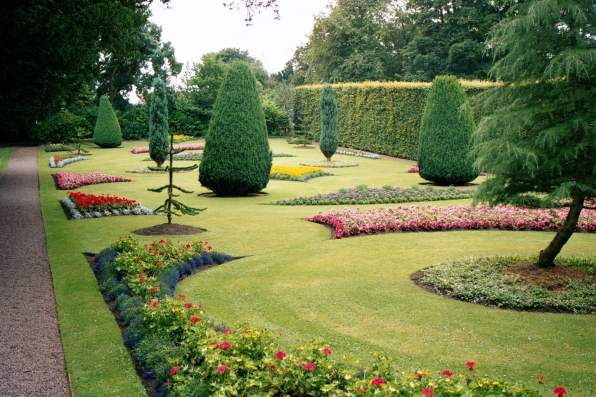
The many gardens at Direlton are incomparable!
The asphalt walkway was
bordered by an immense beautiful lawn and we passed a well-preserved
Dovecott on our way to the castle. We hurried our walk to avoid what we
thought was to be an onslaught of camera-carrying Japanese tourists that
were disembarking behind us and we wanted to get some unobstructed photos
without people in them. The onslaught never came. As we reentered the shop
on our way out 30 minutes later, the tourists were arguing with the clerk
that the fee (the cheapest we'd found in the entire country and really
very low) was too much for them to pay. In fact, they expected to get in
free!
The castle itself was in
ruin, as most of the ones we saw were. But understand, that 'in-ruin'
could mean anything from a few walls left to entire buildings intact with
just a few walls missing. Direlton had dozens of rooms to explore,
wonderful gardens and grass areas to explore. This would make a wonderful
place for a picnic and an afternoon's wandering.
We stopped by a small
grocery and looked for a decent map. This was the third I had purchased
and none seemed any better than it's predecessor at getting us from one
point to another. We probably lost a full day or more of our trip taking
unscheduled / unplanned sidetrips due to the innocuous detail of the
maps we had.
We proceeded south down the
coast to Tantallon castle. This castle is right by the sea with a terrific
view of historic Bass rock and the surrounding ocean. There is a nice
leisuly walk along a grass pathway to reach the castle that was one of so
many that was destroyed by Cromwell when he decided to use every castle in
Scotland for target practice. We identified so many reasons to understand
why some of the Scots to this day have issues with the English.
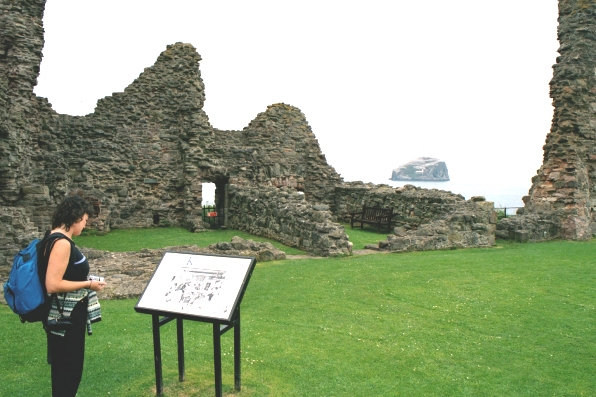
Tantallon castle. A mighty edifice with a
beautiful of the ocean and famous Bass Rock.
This castle was several
stories high and had many neat rooms and dark hallways to explore. On top
of the parapets we could see across the ocean for miles. The views once
again were spectacular!
One of the most impressive
castles in southern Scotland, Tantallon Castle is a large and once strong
14th-century courtyard castle, now ruinous. It consists of a massively
thick 50-foot-high curtain wall, blocking off a high promontory, the sea
and the height of the cliffs defending the three other sides. In front of
the wall is a deep ditch, and at each end are ruined towers: one round,
one D-shaped. The shell of a massive keep-gatehouse stands at the middle
of the wall, and rises to six stories. Within the castle walls are the
remains of a range of buildings, which contained a hall and private
chambers. The castle was built by William Douglas, 1st Earl of Douglas,
about 1350. William waylaid and slew his godfather, another William
Douglas, the infamous 'Knight of Liddelsdale', and secured his position as
the most powerful lord in the Borders. George Douglas, his son, became the
1st Earl of Angus, the first of the 'Red Douglases'. Archibald, the 5th
Earl, known as 'Bell-the-Cat', hanged James III's favorites, including
Cochrane, from the bridge at Lauder. He entered into a treasonable pact
with Henry VII of England, which led to James IV besieging Tantallon. In
1513 Douglas died, and his two sons were killed at the Battle of Flodden.
The castle was attacked again in 1528 by James V; and Mary, Queen of
Scots, visited in 1566. In 1651 Cromwell sent an army to seize the castle,
as men from Tantallon, as well as Dirleton, had been attacking his lines
of communication. The bombardment had lasted only 12 days when the
garrison surrendered. The castle was damaged and became ruinous, and was
sold to the Dalrymples in 1699. It was taken into the care of the State in
1924. Short walk to castle.
As we traveled we went to
Dun's castle only to be turned away by a 'private' sign. Many of the
castles of Scotland remain in private hands and are inaccessible. Heather
and I walked up to a caretakers gate with the full intention of just
walking right up to the castle and then, not knowing the trespassing laws
of Scotland, decided to take the more judicious route by walking some
nearby trails. We passed some grazing cattle and decided to follow a trail
along a fenceline that paralleled the river about 1/2 mile downhill from
us.
We found a path through
some heavy woods that led to a hilltop view of the entire area. We found
some old historic markers and some bunkers that looked like old military
buildings. One of the fascinating things about Scotland is that even when
you don't know exactly where you are going you almost always stumble upon
something exciting to behold. There apparently was a settlement here at
one time that was marked by a 'Coventor's Stone' in the ground.
We drove on to Floors
castle in Kelso. This is the ancestral home to the Duke and Duchess of
Roxesburgh. We saw only a small, (thus overpriced) portion of the castle
as the royalnesses still lived in the castle with their family. We had a
nice (miniature) cup of coffee in a quaint little courtyard and had a very
nice walk around the grounds. As we were driving away a car came careening
towards us through the grass. It kept swerving on and off the road and I
warned Heather to hang on because the 'idiot' just might mistake us for
the roadway as it had been thinking the grass was part of the road! The
car passed us almost running us off the road and we recognized the driver
as the Duchess of Roxesburgh! Ah the ability of royalty to endear itself
to the common folk with their quaint ways of travel!
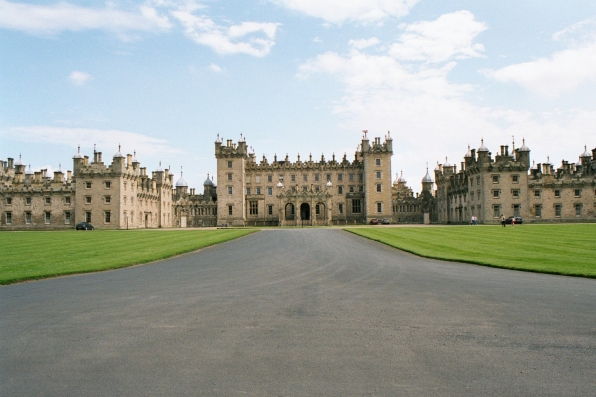
Flors Castle in Kelso. The short tour of this
large castle, home to the Duke
of Roxesburgh, is pleasantly extended by a leisurly walk about the
grounds.
The largest inhabited
mansion in Scotland, the present house consists of a large towered and
turreted central block with other wings and ranges. The building dates
from 1721, and was designed by William Adam for the 1st Duke of Roxburghe.
The house was remodeled in the 19th century with a profusion of spires and
domes, corbelling and battlements, to the designs of William Playfair.
Floors is still the home of the Duke and Duchess of Roxburghe, and was
used in the film Greystoke. Collections of furniture, tapestries, works of
art and porcelain. Walled garden and park.
Continuing our travel today
we came upon Hume castle in the early afternoon. This was an odd looking
castle with wall tops that resembled the top of a rook chess piece. Access
was by a rather steep trail and we were quite alone in the castle. It
consisted of an exterior wall only and one rather tall turret in the
corner facing where our car was parked 100 yards down the hill. The view
from here was spectacular, and combined with the relative remoteness of
the castle and lack of visitors, we were able to thoroughly enjoy some
highly memorable moments up there overlooking the country for hundreds of
miles in each direction!
We then proceeded to Markle
castle, where the St. Andrews cross was seen by a Scottish general before
a battle that was decisively won by the Scots! (Interesting how this
location is claimed by several establishments as 'the' spot where the
cross appeared in the sky before the historic battle!)
Sunday July 28th
Our charge cards would not
work in the Haddington ATM machines so we had to pay the proprietors of
Markle House in traveler's checks. Jim Mcguinnes figured out our tariff
and we were on the road to Carbisdale castle, 6 hours north!
The drive was magnificent!
The countryside was beautiful and we marveled at the speed with which most
travelers progressed along the carriageways!
Upon arrival at the
Carbisdale castle we went for a nice walk through the adjoining woods. The
drive to the castle took us through several miles of countryside down a
roadway wide enough only for one car. This became exciting as I exceeded
every speed limit known to man out of sheer exuberance of the joy of
driving through such beautiful land! We passed sheep by the hundreds. I
might add, that the sheep all were quite different than the breeds we have
in America. They all had black around their faces and they seemed much
smaller than American-bred sheep.
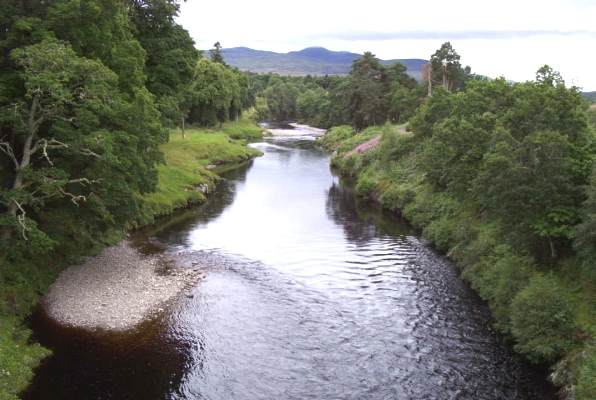
Wick river, near Carbisdale Castle, near the
town of Tain, county of Ross & Cromarty.
Carbisdale castle is a
huge, old castle converted to a Youth hostile. I expected to see a
dilapidated, graffiti covered building when we arrived. Pleasantly, it is
an actual old castle still furnished with several marble statues inside
the halls, marble fireplaces, beautiful hardwood floors, immense reading /
library rooms, and several floors of rooms to explore. Meals were communal
and Spartan, but good. We appreciated the Carbisdale hosts for supporting
our diets with portion sizes gauged for Lilliputians and Leprhicans, while
supporting the local economy because we all had to supplement our immense
portions of 5 star meals with food bought from nearby groceries. Sometimes
we had nice conversations with the dozens of other travelers staying
there. Accents from all over the world could be heard. I was very glad
that Heather had done some research and obtained for us a 'family' room
because otherwise we would have had to share communal rooms with others of
the same sex and we would have had to sleep apart. At meals the other
travelers talked about all the late night revelers who came into the rooms
at all hors of the night and sleep for this light sleeper would probably
have been nonexistent.
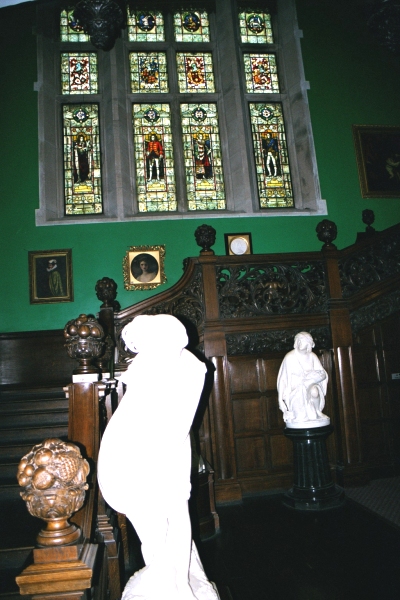
Interior of "haunted" Carbisdale Castle. The
furnishings,
stained glass, and decor are wonderful to behold!
We had a small room with
two single beds that we promptly took the mattresses off and put them
together on the floor. There was a semicircular bay window all around the
room that would have afforded a beautiful view had we wanted to share the
view into OUR room with all the travelers walking by outside. I could not
for the life of me get the window open to get some fresh air in and the
steam from the shower next door added to the already moist air of the
ever-rainy north of Scotland.
Have I mentioned the
toilets yet? It is obvious from the amount of rainfall Scotland gets (we
had 19 out of 21 days of rain) that they do not have to practice water
rationing as we sometimes have to do here in California! If they ever do,
I am going to get the lock on water conservation toilets and a franchise
on installing them. Why you might ask? When you flush a Scottish toilet,
the amount of water that rushes down the toilet reminds you of the rapids
of a storm-swollen river surging down that toilet pipe, and you don't want
young children standing nearby because the draft will most assuredly suck
them in! I am sure the water level of the nearby rivers must drop
substantially everytime someone flushes! Really rather surprising
considering the mechanisms on all of these toilets look like William
Wallace must have installed them!
Monday, July 29th
Ah Inverness, gateway to
the Highlands of Scotland! Who hasn't heard the romantic ruminations in
song and film of the Highlands. We enjoyed the downpour that accompanied
us for 2 hours from Tain (the town nearest Carbisdale castle) and as we
went from shop to shop in a futile attempt to find more 'Walker' stuff and
things Scottish to bring home to the kids and family!
James Pringles Weavers was
our first stop. That is after 2 false starts at Pringle shops along the
SAME road! We bought tons of stuff there, including Bus 'Walker' cookie
tins for Jalissa and Skyler, scarves, ties, mugs, etc. I was a bit of a
pain to the 'Pringles' as I insisted in making 'my own tartan on their
ancient weaving machine'. (They advertised that we could do that and darn
it, when would be coming back ACROSS A WHOLE OCEAN again to give it a
whirl eh? Well, I was the only person allowed to do that that day and I
must say it was fun sitting on the peddle-powered machine as the adults
passing by looked at me as if they thought I should have been a wee bit
younger' to be playing on the cute little weaving machine' don't ya know!
I was honored with a certificate and an actual piece of the cloth I made
on the ole machine, which I am proudly displaying at this very moment at
the bottom of a box somewhere!
Ah lads and lassies, get
comfortable in yer seats because around a bend or two we are coming to the
part of this adventure ye all ave been waitin fer! Yes, on this
appropriately overcast and drizzly day, with the wind moaning and the
roadways slick with rain, we arrived at the most hallowed ground any
tourist can visit in Scotland, none other than the legendary Loch Ness
lake!
Yes ladies and gentlemen
you could cut the tension with a knife as we traversed the side of this
Loch with breath-holding anticipation of encountering one of the most
tantalizing creatures ever to be known to man, the legendary Loch Ness
Monster!!!!!!!!! (thunder and lightening fills the skies and flickers the
lights).
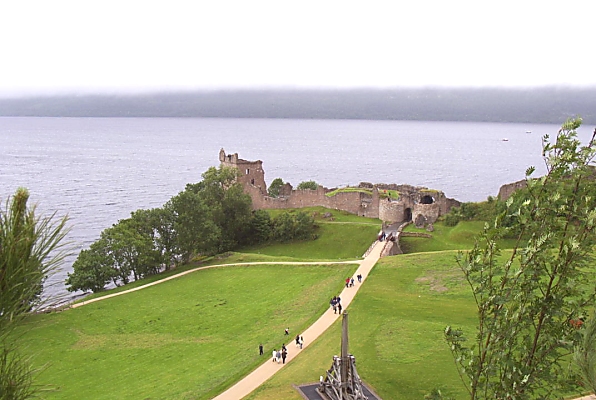
Urquart Castle, on the shores of Loch Ness!
Yes, we traveled for what
seemed like hours (5 minutes) along that fabled shore before curiosity
drove us to disembark our luxury transportation (our subcompact car) and
make our way down a precipitous slope to the waters of the Loch Ness!
(more rumbling and lightning!) "Stay back woman" I warned Heather in
ominously quiet words so as not to frighten the creature, " Nessie may be
down here at the water's edge as we speak!" After taking an hour to make
our way down the 20 yards from the car to the shoreline, we were greeted
by a most ominous site that sent shivers down both our spines. There
before us lay the waters of... the legendary Loch Ness!!!!!!!!!!!!
Nerves of steel on edge for
any sound, I allowed my woman most-beautiful to join me at the water's
edge. The eyes of a trained hunter scanned the rippling water for any sign
of movement that would betray the approach of the marine behemoth. Ears
trained from years of stalking the enemy in Cambodia and the wild pheasant
back home listened for even the slightest ripple or splash that would warn
of impending Nessie-danger.
I knew we were close,
primal senses awakened since I touched my sacred ancestral soil told me
Nessie was nearby. My vigilance paid off, as rising out of the water not
30 yards away was Nessie herself in all her prehistoric glory. Almost
speechless from the sight, I turned to see the beauteous Heather preparing
to take my picture. I pointed to the behemoth behind me and knew I had
scant seconds to get my woman to safety! The whir of the camera told me we
had all we needed to immortalize on celluloid the most amazing creature
known to man! Heather had been concentrating on taking my picture and had
not seen Nessie rearing out of the water behind me. I so knew how much she
loved me as she saw the monster and screamed 'here's your camera' and
chucked it at me as she wheeled and fled up the embankment to safety,
bashing me in the head in the process. (Explaining the word 'Cannon'
impressed backwards into my forehead became quite the source of
entertainment for Heather for the rest of the trip!)
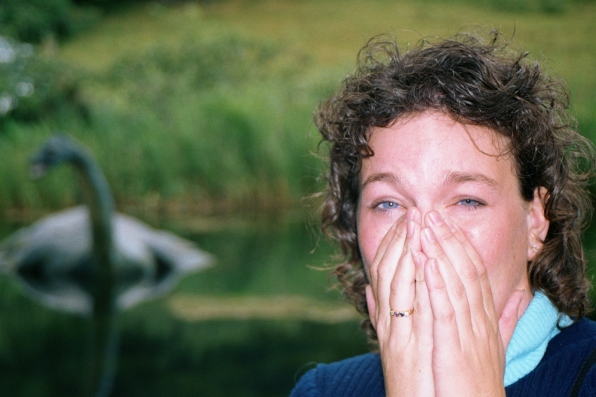
My heart was overwhelmed
with love for my woman as I watched her leave me behind, scampering up the
embankment without even a glance back to see how I was doing. As Nessie
roared through a throat that was eons old, I fought back branch after
branch that Heather let fling towards my face. How proud I was of her
ability to keep her footing up that slippery, muddy slope. I yelled to
Heather " hurry honey, run faster so you can outrun the monster and not
get caught! With all the love in her heart she responded "it's ok Jim, all
I have to do is outrun YOU!"
I swear I felt the hot
breath of prehistoric breath upon my back as I chased our car down the
road yelling for Heather to ' wait for me'!!!!!!!!!!!!!!!!!!!! Ahhhhhhh
true love!
Regards,
Jim Walker
scotlandforever7@aol.com
http://hometown.aol.com/scotlandforever7/myhomepage/profile.html
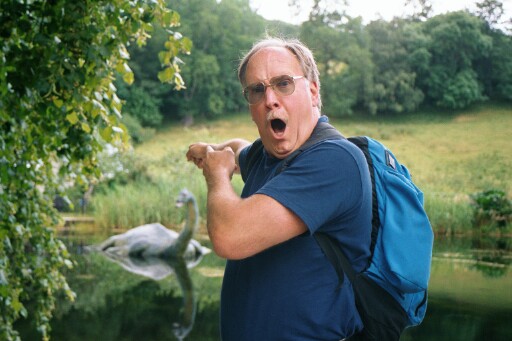 |

